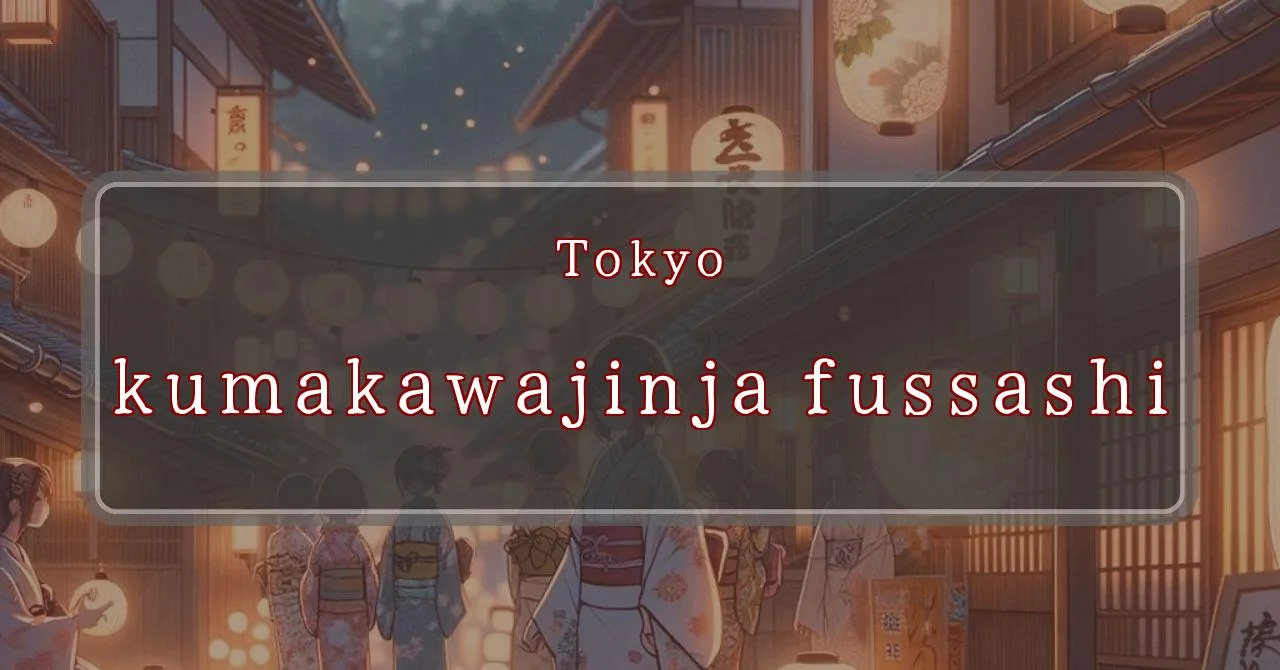Divine illumination at Kumogawa Shrine
Basic Information
Kumogawa Shrine is a Shinto shrine located in Fussa City, Tokyo, Japan. It is dedicated to the deities Ōkuninushi and Ichikishimahime, and is also known as Fukusei Shichifukujin, or the Seven Lucky Gods of Fukusei.
- Address: 660 Kumogawa, Fussa, Tokyo 197-0003
- Phone Number: 042-551-0720
- Access: 15 minutes on foot from拝島駅 (Haijima Station) on the JR Ome Line, or 10 minutes on foot from 熊川駅 (Kumogawa Station) on the JR Itsukaichi Line
- Festival Days: September 1st (Reiwa 6)
Main Events and Attractions of the Festival
The Kumogawa Shrine Festival is an annual event that takes place on September 1st. The festival features a variety of events and attractions, including:
Mikoshi Procession
The mikoshi procession is the main event of the festival. A mikoshi is a portable shrine that is carried through the streets by a group of people. The mikoshi is believed to be inhabited by the deity of the shrine, and the procession is a way to show respect to the deity and to pray for good fortune.
Lion Dance
The lion dance is a traditional Japanese dance that is often performed at festivals. The dance is performed by two people, one wearing a lion costume and the other playing a drum. The lion is believed to bring good luck and fortune, and the dance is a way to pray for a prosperous year.
Taiko Drumming
Taiko drumming is a traditional Japanese form of drumming that is often performed at festivals. The drums are large and heavy, and they are played with wooden sticks. The drumming is very loud and energetic, and it is a way to create a festive atmosphere.
Food Stalls
There are many food stalls at the Kumogawa Shrine Festival, selling a variety of traditional Japanese foods. Some of the most popular foods include yakitori (grilled chicken), takoyaki (octopus balls), and taiyaki (fish-shaped cakes filled with sweet bean paste).
Games and Activities
There are also a number of games and activities for children at the festival. These include things like ring toss, beanbag toss, and goldfish scooping.
Blessings and Deities
Kumogawa Shrine is dedicated to the deities Ōkuninushi and Ichikishimahime. Ōkuninushi is the god of marriage,縁結び (enmusubi), business prosperity,商売繁盛 (shōbai hanjō), and good luck,家内安全 (katei anzen). Ichikishimahime is the goddess of music,芸能 (geinō), wealth,財運 (zaion), and good fortune.
Origin and History
The origins of Kumogawa Shrine are unclear, but it is believed to have been founded in the early Heian period (794-1185). The shrine was originally known as Reihai Daimyōjin, and it was dedicated to the deity Ugajin, the god of agriculture and industry. In the Edo period (1603-1868), the shrine was renamed Kumogawa Shrine and the deities Ōkuninushi and Ichikishimahime were enshrined.
Tips and Notes for Visitors
- The Kumogawa Shrine Festival is held annually on September 1st. The festival features a variety of events and attractions, including a mikoshi procession, a lion dance, taiko drumming, food stalls, and games and activities for children.
- The shrine is located in a quiet residential area, so please be respectful of the neighbors when visiting.
- There is a small parking lot at the shrine, but it is often full during the festival. There are also several coin-operated parking lots in the area.
Parking Information
There is a small parking lot at the shrine, but it is often full during the festival. There are also several coin-operated parking lots in the area.
Popular Stalls and Food Carts in Recent Years
| Type of Stall | Description |
|---|---|
| Takoyaki | A staple at Japanese festivals. Characterized by a crispy outside and a creamy inside. |
| Jaga Butter | A simple yet popular snack of hot potatoes lavishly topped with melted butter. |
| Baby Castella | Small castella cakes, sweet and fluffy treats enjoyed by children and adults alike. |
| Grilled Ayu with Salt | Fresh ayu fish grilled whole with salt, a savory taste of Japanese summer. |
| Shaapin | A unique gourmet item influenced by foreign cuisine, with a chewy skin wrapping the filling. |
| Okonomiyaki | A Japanese grilled dish where you often choose your own ingredients for a personalized flavor. |
| Cotton Candy | A fluffy, sweet snack that’s extremely popular with children. |
| Chocolate Banana | A banana coated in chocolate, a fun and visually appealing dessert. |
| Kushiyaki | Various types of ingredients skewered and grilled, an easy-to-enjoy snack. |
| Yakisoba | Fried noodles mixed with a special sauce, a fast food favorite in Japan. |



